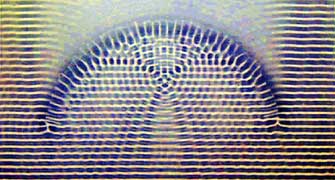
 |
 |
Technology |

 |
|
 |
The Cone Drainage A Discussion
Technology: The Svelte Shelf
Using Loudspeaker Diaphragm Sandwich Technology in Equipment Supports
One of the goals of a good equipment support is that the surface the component "sees" not be subject to random vibration. Imagine a surface of water churning with great turbulence. If the water were to freeze, the surface would cease to exhibit the same degree of turbulence. In similar fashion, the surface of a support shelf should be like a frozen lake- exhibiting as little "break up" as possible.
The same goal is desirable for audio devices- both in component supports and in another, related application, the loudspeaker diaphragm. In a technical paper published in the Journal of the Audio Engineering Society in June, 1970, D.A. Barlow described empirical findings that almost echo the parameters which dictated the original Svelte Shelf design. This first description of a loudspeaker "sandwich diaphragm" specified a light core material with rigid outer skins. Of course, the reason for a light core in the speaker diaphragm is to preserve a low mass diaphragm and reduce moving mass (perhaps the most important parameter in an accurate speaker driver); since the Svelte Shelf is not a speaker, the need for low mass isn't specifically necessary. The core of the Svelte Shelf is a closed-cell foam with good thermal absorption characteristics. With a mediating "interlayer" between it and the dense stainless steel tops and bottoms to improve transmission (see "Mechanical Impedance Matching in Symposium Platforms"), it becomes a good "heat sink" to convert mechanical energy into heat. As we saw with cones, part of their effectiveness is realized by interfacing the component with less area of the support surface and therefore reducing the amount of spurious vibration that can enter the component through the cone support; another way to achieve this goal is to ensure that the surface isn't vibrating too much. In a loudspeaker diaphragm, this is called diaphragm "break up;" the same principle is at work in an equipment support shelf. The surface of the shelf, like the surface of a turbulent body of water, deforms or "breaks up" under the influence of mechanical energy or vibration, causing "hot spots" and "dead spots" to form on the surface. Exactly where the hot spots and dead spots are depend upon many factors, such as the frequency and intensity of the energy, its entry angle, the surface density and rigidity, temperature, etc. etc., and where you happen to place your component's feet or cones on such a surface becomes almost like playing the lottery. The difference between trying to find the right spot for your component's feet placement on such a surface differs from playing the lottery, however, because in the lottery, there will always eventually be at least one winner. The chances of your shelf having three (or even one) "good" spot(s) is not guaranteed! So, this is why where you place your equipment feet can have a surprising effect upon your system performance, because you will be plugging in to one of these spots or another. It is important to point out that this problem is an important aspect of vibration control with is not avoided by even a theoretically perfect, so-called "isolation" platform- because the top surface of these platforms are made of ordinary materials and thus will be vibrating from energy received from air-borne sound or the component itself. The best way around this problem is to try to reduce surface "break up" as much as possible- and a good way to do this is to make the surface as rigid as possible. Stainless steel has a very high rigidity, and that's why we use it in the Svelte Shelf.

Thus, the idea behind the Svelte Shelf is to improve component performance by draining away and dissipating unwanted mechanical energy from your equipment's chassis in an acoustically neutral medium, thus reducing noise in the component. Induced noise interacts with the circuit paths in all electronic components, causing spurious secondary currents. These intermodulate with the desired signals and thus add distortion. The Svelte Shelf reduces noise (and thus, distortion) in the component by providing a neutral mechanical "ground" for energy to drain to and be dissipated in, without adding any additional "processing" to the signal. Thus, it works not by "improving" or "enhancing" the performance of your component, but merely by allowing it to operate closer to the theoretical limits of its design parameters, which are determined by its designer. All so-called "isolation" devices, be they feet, cones, platforms, air-bag systems or what-have-you, achieve their results by changing the vibrational characteristics of the components they interact with. If the total energy in a component remains the same, all the device has done is to change this energy from one frequency or mode to another. The goal is not to transmute this energy, but to eliminate it. While vibration will be reduced which would otherwise come from the support structure, an "isolation" device per se cannot treat internally generated noise (such as from power transformers, spinning disc motors, or vibrating solid state devices), or even vibration that is picked up through the chassis itself from sound that travels through the air.
Specifically, the Svelte Shelf achieves these goals by:
1) providing a high degree of rigidity (high "Young's Modulus,") in its top and bottom surfaces
2) minimizing or eliminating inherent mechanical resonances (which all materials have) through "constrained layer" principles (its stainless steel top and bottom layers are uniformly bonded to an interlayer between them and the foam, and any tendencies toward resonance are inhibited)
3) further minimizing inherent resonance through offsetting, dissimilar mass top and bottom "skins"
4) providing a center foam "heat sink" which can dissipate mechanical energy as heat.
Deploying the Svelte under loudspeakers - the how and why
The speaker should be placed flat down onto the Svelte, WITHOUT spikes. While spikes are a useful and effective device, their function, when compared to a full Svelte Shelf, is somewhat limited. This is because the spike is an energy conduit between the speaker's cabinet and its support structure (in most cases, a floor). Excess mechanical energy which exists in the loudspeaker cabinet intermodulates with the action of the loudspeaker diaphragms - and this is true of dynamic or electrostatic speakers. As the cabinet shakes, it also moves the actual diaphragm through its support frame- subtlely blurring and muddying sound quality.
The less extraneous mechanical energy in the speaker's cabinet, the better - all you want to be moving is the speaker's diaphragm - and the speaker frames and their supports should be absolutely solid and unmoving. Unfortunately, this is a virtual impossibility. Even with state of the art loudspeakers with extremely heavy resin-cast cabinets weighing hundreds of pounds, some energy will still be present, and this energy exerts a negative influence upon the speaker's movement. And while it's nearly impossible to completely eliminate this by-product of real speaker drivers in a physical world, it is possible to lessen the amount of energy. Spikes provide a good conduit out of the cabinet - but are rather small conductors. Various manufacturers have approached the problem by combining different metals or carbond fiber materials together in an effort to improve performance - but the problem is that, when all is said and done, they're still constrained by the basic spike itself, which is a limited pathway.
Home | Products | Technology | Reviews | Dealers | F A Q | Set Up Tips | The Gallery | What's New | About Us | Links | Privacy Policy | Contact Info
Copyright © 2002 Symposium USA, Inc. All Rights Reserved